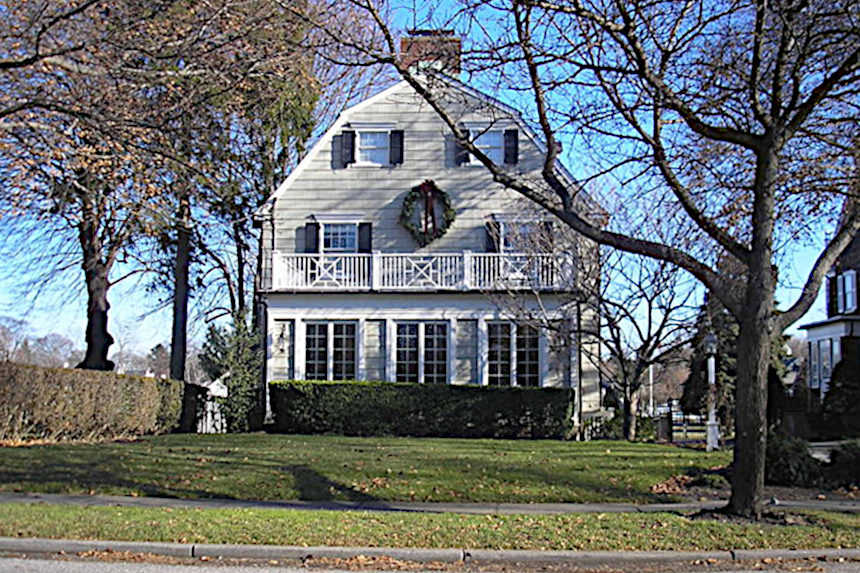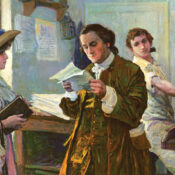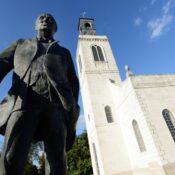Audiences love films based on true stories. Audiences also love films based on true, scary stories. Forty years ago, The Amityville Horror screamed its way into theaters. Based on the 1977 book by Jay Anson, the film relates the story of the Lutz family, who purchase a house without knowing of its murderous history. For decades, critics have called the allegedly true story of the Lutzes a hoax; it’s been the subject of books, TV news investigations, and legal proceedings. True believers, like the late spiritual investigators Ed and Lorraine Warren, propelled the story forward. In terms of the film itself, it spawned a franchise, remakes, and continued interest throughout the forty years. Here’s a look at origins, the film, and why it might survive in public consciousness today.
To get to the bottom of the Amityville phenomenon, you have to dig into the particulars of the original crime. In November 1974, Ronald DeFeo Jr. of Amityville in Long Island, New York, killed his parents, two brothers, and two sisters at the family’s home on 112 Ocean Avenue. DeFeo initially tried to pin the murders on a mob hitman, but eventually confessed to the murders a day later. Despite an argument of insanity, DeFeo was convicted of six counts of second-degree murder and handed six concurrent 25-to-life sentences. He is, as of this writing, still in the Sullivan Correctional Facility in New York.
One month after DeFeo’s 1975 conviction, George and Kathy Lutz and their three children moved into 112 Ocean. The Lutz family did know about the house’s history at the time of the sale. They left 28 days later. Their reason? They claimed that almost from the beginning, they fell under siege from supernatural forces within the house. Accounts vary, but from that point, the Lutzes met with and sold the rights to their story to writer Jay Anson, known primarily at that point as a writer for documentary shorts (like 1973’s Martin Scorcese: Back on the Block). Anson wrote The Amityville Horror, and it was released in September 1977.
The book caught public attention from the outset. Promoted as a “true story” but labelled a “novel,” the marketing leaned heavily on the idea of the book presenting the events of a real haunting. Anson later said that he embellished certain aspects of the story, and George Lutz would insist in later interviews that “most” of the book was true. The book, with its depictions of massing flies, apparitions with glowing red eyes, and voices whispering, “Get out” became a huge hit. Estimates have it selling in the neighborhood of 10 million copies across its various editions.
Eventually, the film rights went to independent studio American International Pictures. AIP, as it’s informally known, thrived for several decades as a producer and distributor of horror films. The studio budgeted Amityville at a modest $4.7 million, casting James Brolin and Margot Kidder as the Lutzes and Academy Award-winner Rod Steiger as Father Delaney. The movie exploded into a full-blown phenomenon. It would make $86.4 million over the course of its theatrical run, earning almost 20 times its budget and becoming the most successful independent release of all-time to that point (a record it would hold until 1990, when it was eclipsed by the first live-action Teenage Mutant Ninja Turtles film).
One peculiar aspect of the first film’s box office success was that it wasn’t remotely embraced by critics. Big-name critics like Leonard Maltin and Roger Ebert, both of whom had supported genre films in the careers, panned the movie. Ebert wrote that the events depicted were more upsetting than entertaining; he said, “They’ve been made into a dreary and terminally depressing series of glum things that happen to the residents of the Ocean Boulevard house. Nobody who has had to live under a roof and amidst four walls and pay the rent could possibly find such things amusing.” Promotions for the film included film crews following Brolin and Kidder as they visited the real 112 Ocean. However, word-of-mouth was the biggest driver of the film; it stuck around as a consistent moneymaker over the course of several weeks from the summer into the fall.
The original trailer for 1979’s The Amityville Horror. (Uploaded to YouTube by Movieclips Classic Trailers)
In his 1981 non-fiction book on the history of horror, Danse Macabre, Stephen King weighed in at length on both the book and the original film in the chapter “The Modern American Horror Movie—Text and Subtext.” King attributed a good deal of the success of the film to themes of homeowner anxiety and financial ruin that Ebert references. The late 1970s economy had been historically rough, with soaring inflation, high mortgage rates, and runaway gas prices emerging as major concerns. The Lutzes were depicted as having made a substantial investment in the house, and King theorizes that the audience identified with the family, their own fears and anxieties magnified by the supernatural events of the movie. In his summation of the film, King writes, “the main reason that people went to it, I think, is that The Amityville Horror, beneath its ghost-story exterior, is really a financial demolition derby.”
As the film’s success built, lawsuits and recriminations came into the picture. DeFeo’s defense attorney, William Weber, alleged that he and the Lutzes made up the entire haunting story and pawned it off on Anson. Paranormal investigators Ed and Lorraine Warren, the inspiration for The Conjuring universe of films, investigated 112 Ocean after the Lutzes left and stated that the believed the haunting was genuine (this visit is recreated with embellishment as the opening to The Conjuring 2). The Lutzes sued Weber and others in 1979, but their suit was dismissed; George Lutz continued to assert the veracity of their story into the 2000s. James and Barbara Cromarty lived in the house at 112 Ocean for 10 years after the Lutzes, and they’ve said that the only thing that ever haunted the house was tourism.
The Amityville Horror (2005 remake)(Uploaded to YouTube by YouTube Movies)
The Amityville “franchise” continues to this day. As of this writing, 20 films have used the name in the title, some directly attached to the original in a legacy of corporate holdings, and some completely unrelated. The story has been a staple of various ghost documentaries, History Channel episodes, and more over the years; it’s also an ongoing pop culture reference, with everything from Family Guy to CSI making jokes or doing episodes with the general premise as inspiration. While no one can ever truly say if the Lutz family experienced an actual haunting or not, the veracity of the account is almost beside the point; The Amityville Horror is firmly ensconced in pop culture and urban legend, which, true or not, may be how it should be.
Featured image: The actual house from The Amityville Horror in 2005 (Photo by Seluatr; Wikimedia Commons, Public Domain)
Become a Saturday Evening Post member and enjoy unlimited access. Subscribe now



